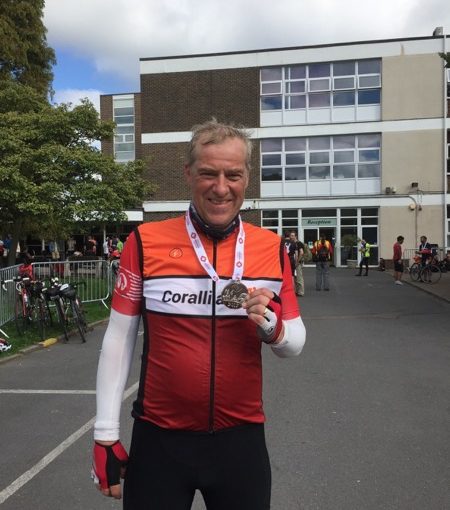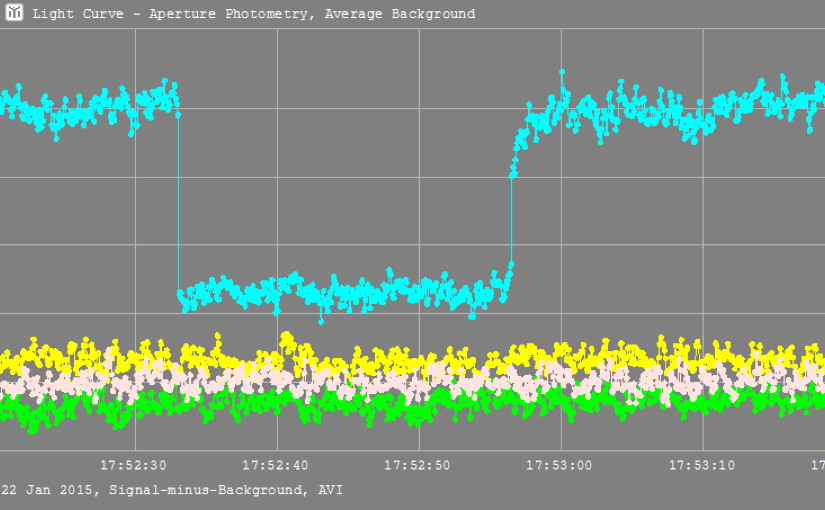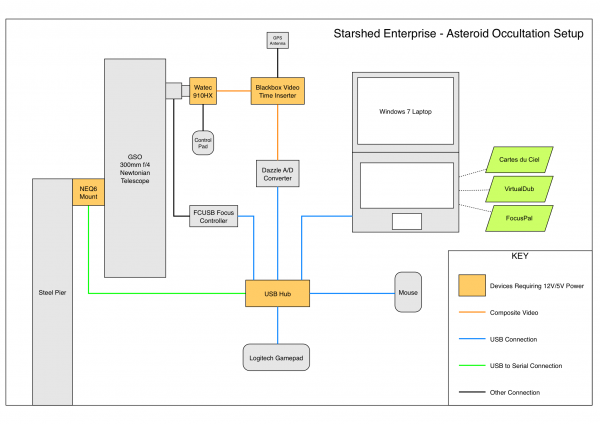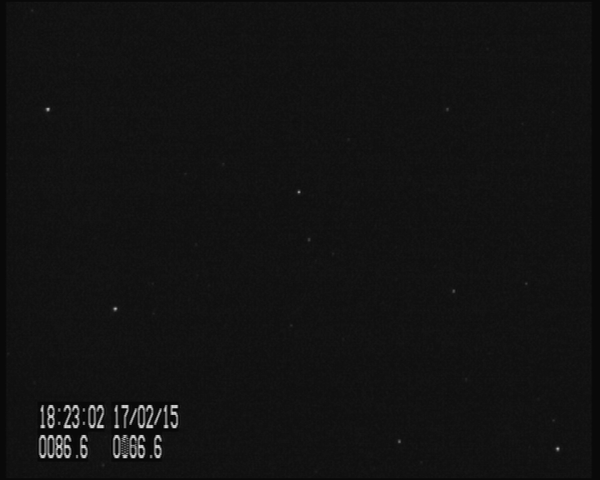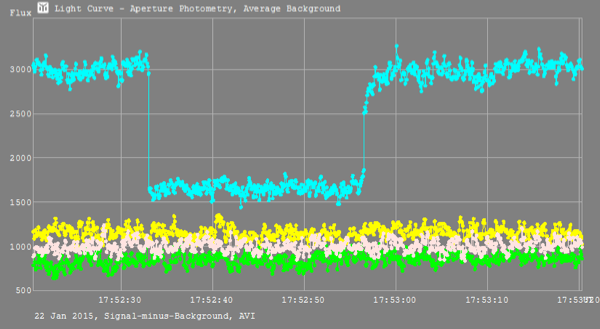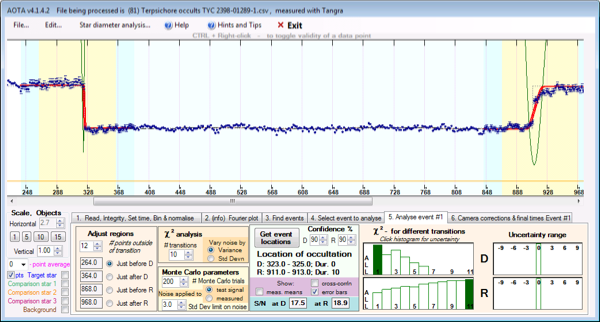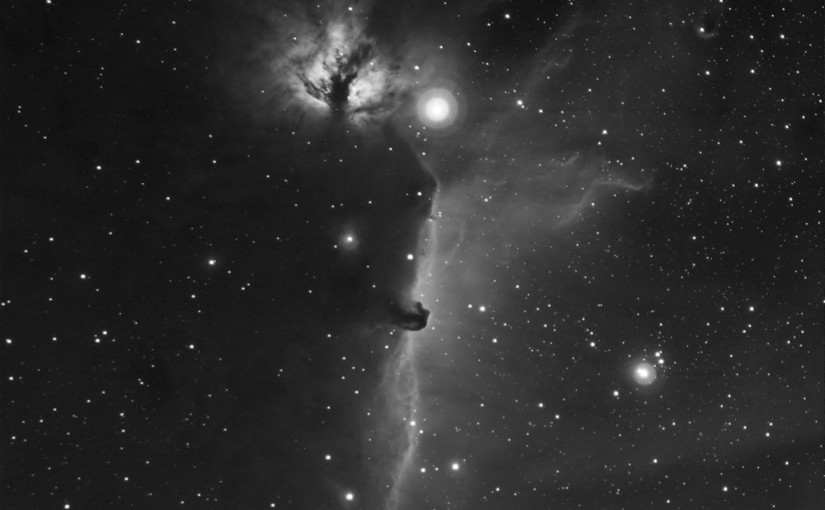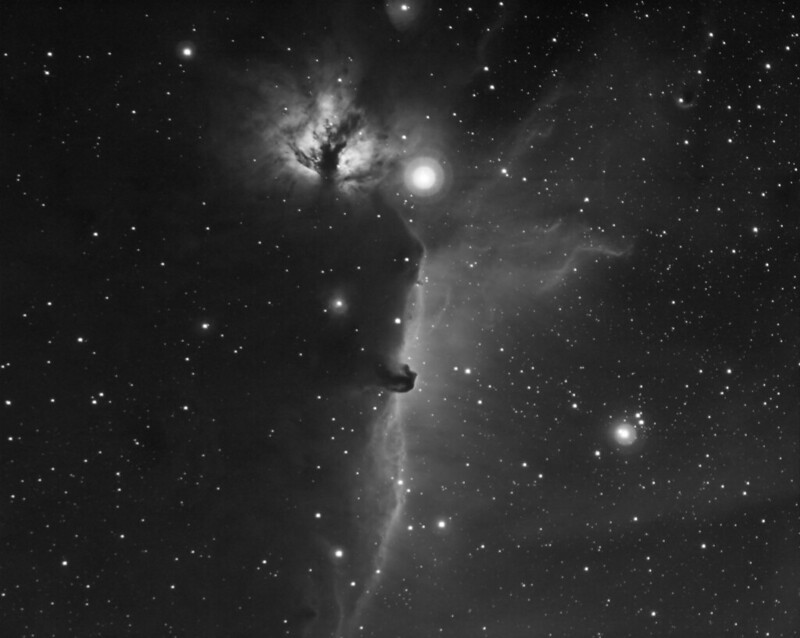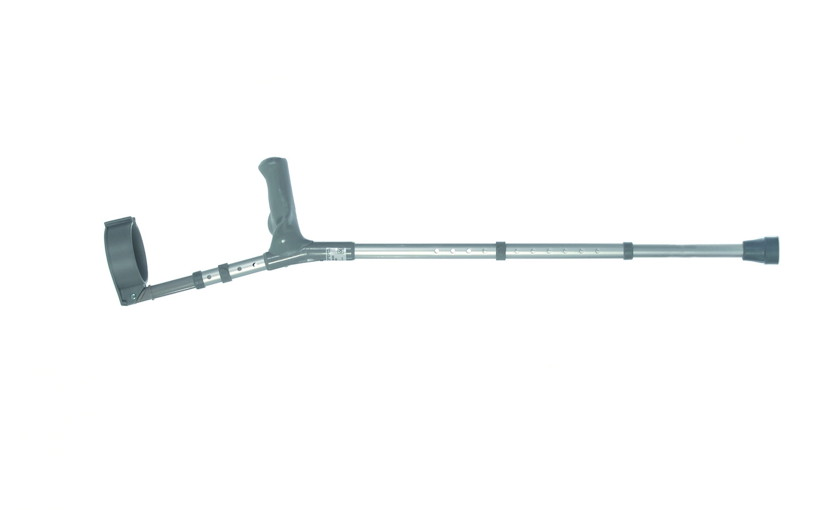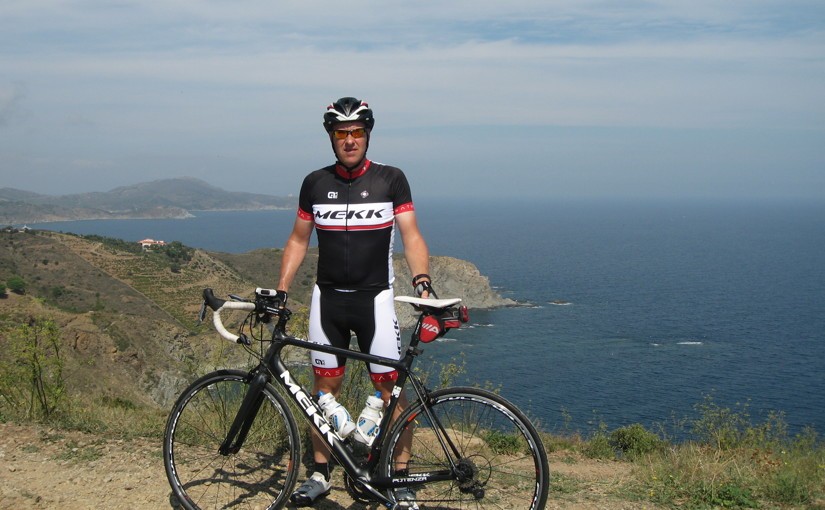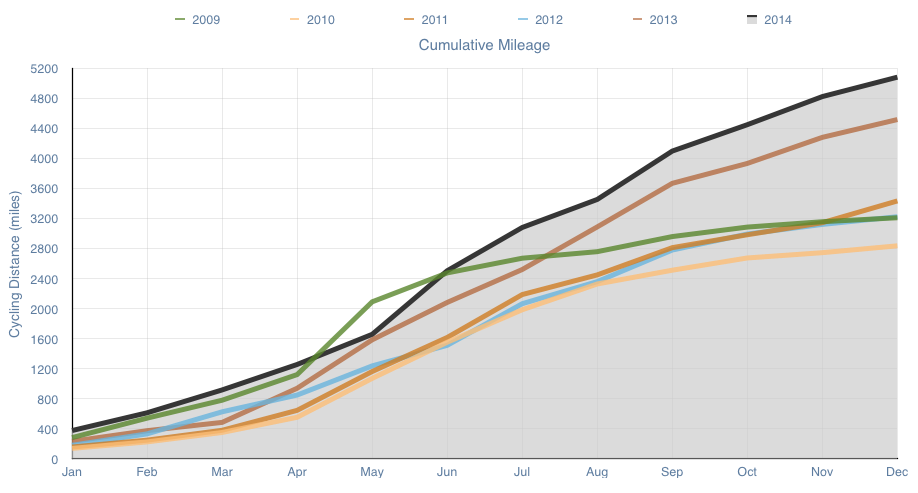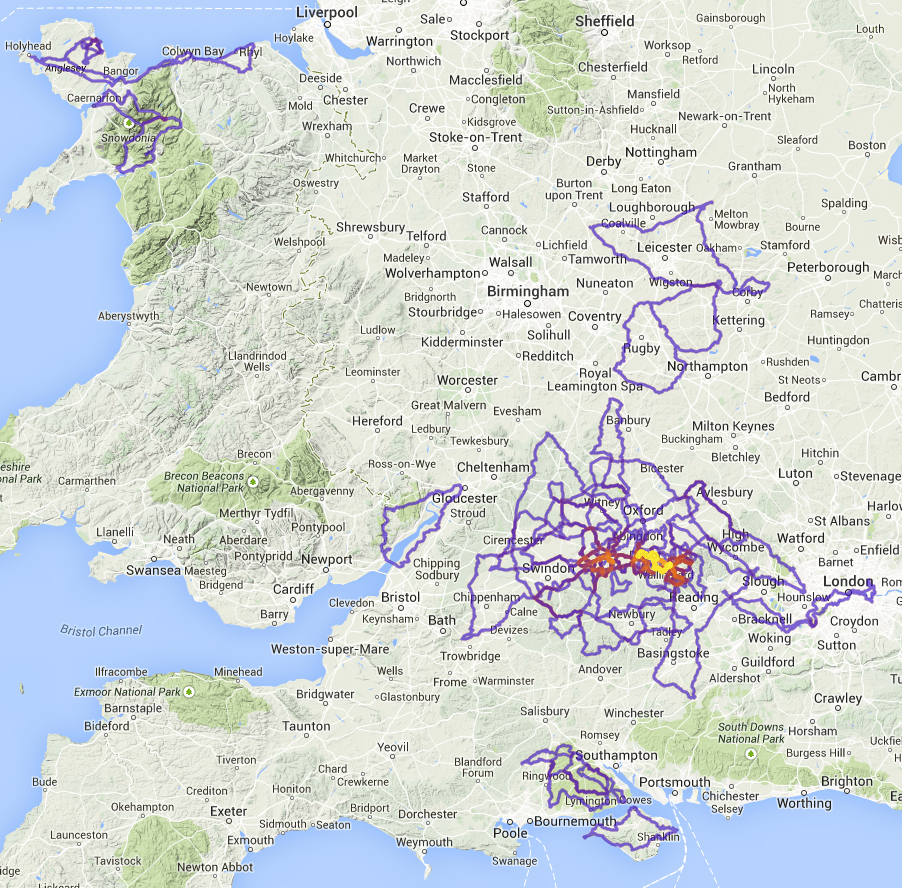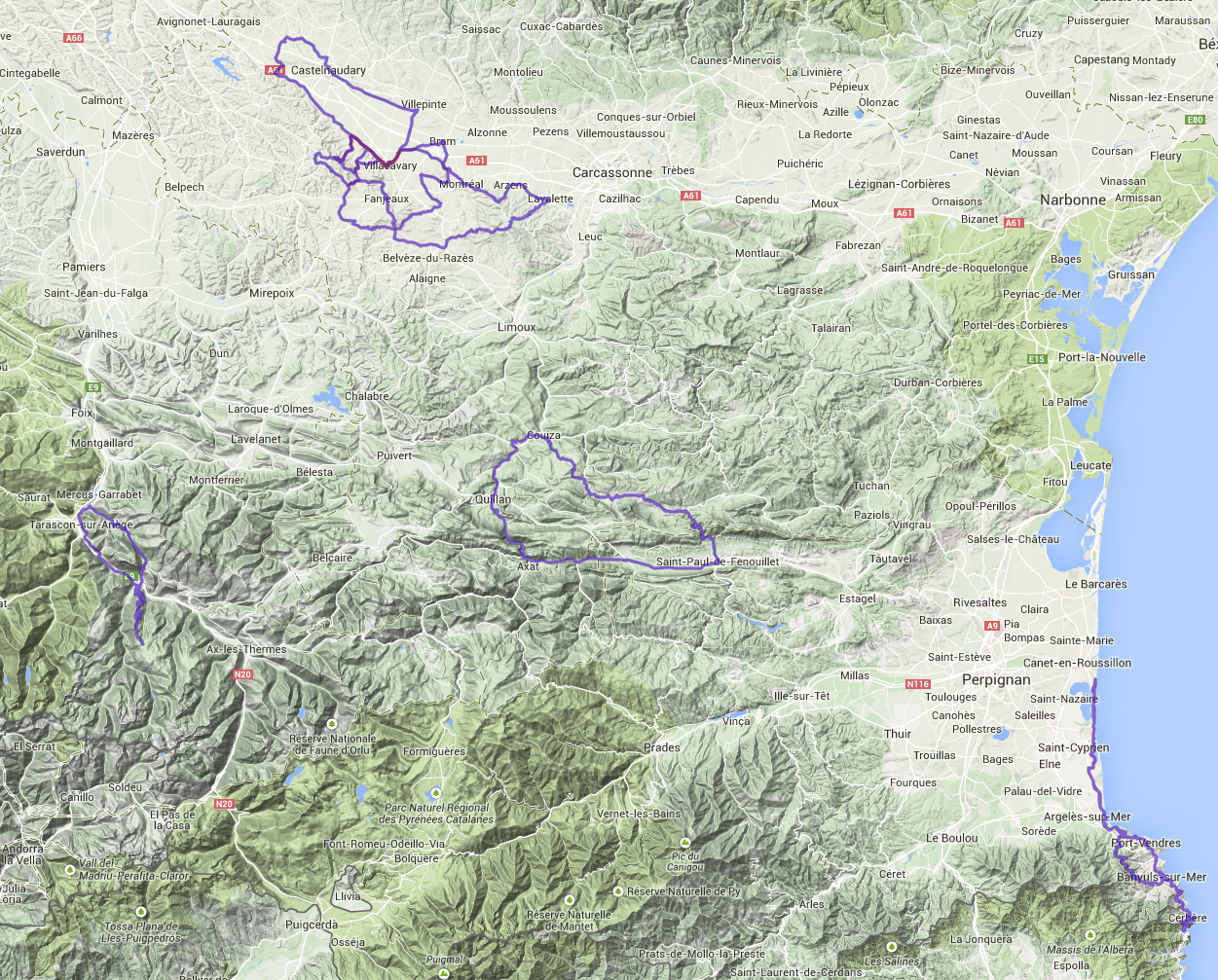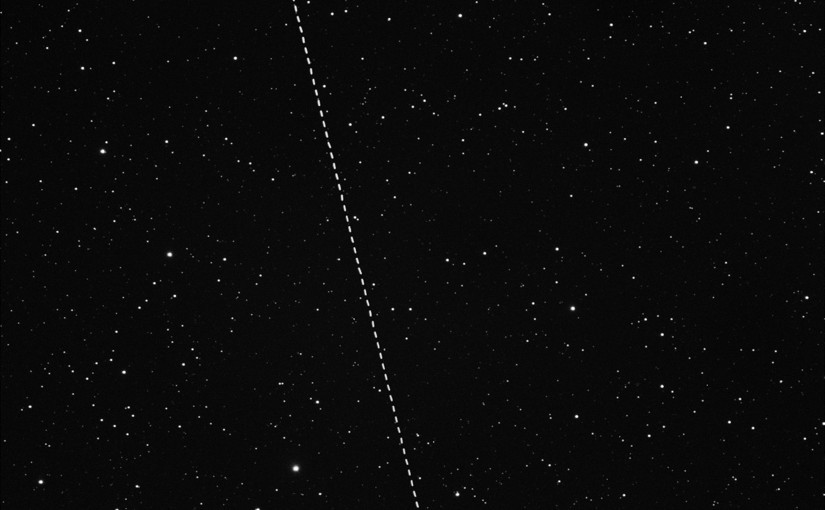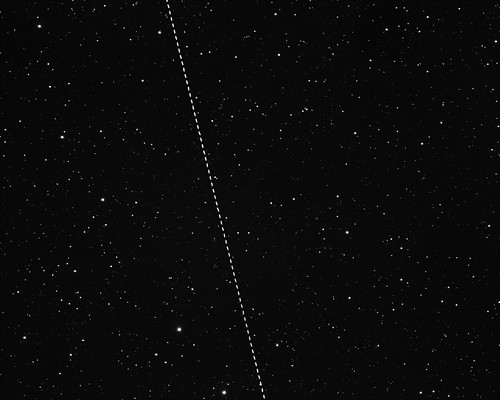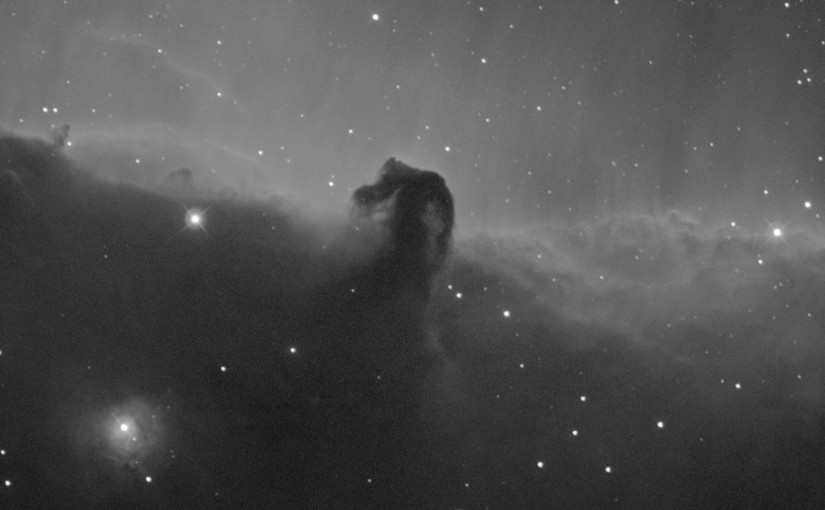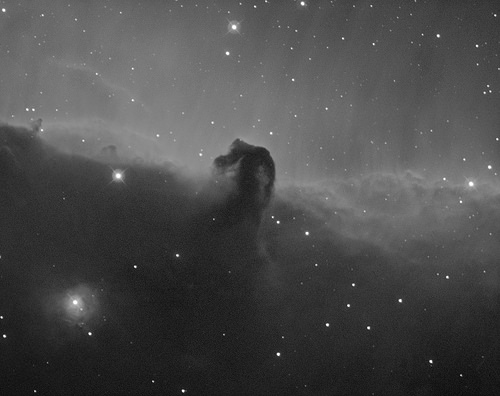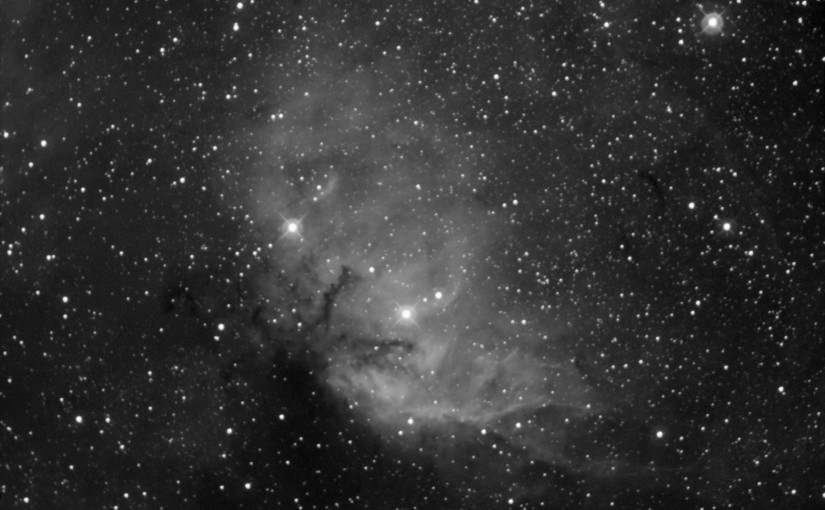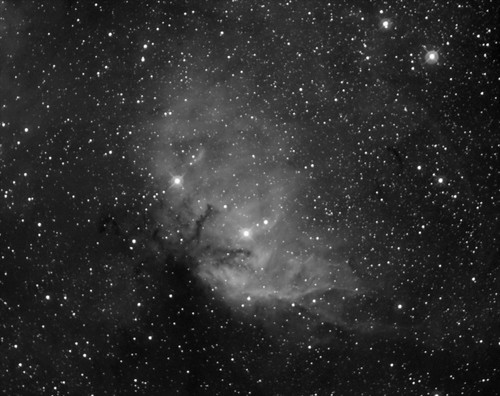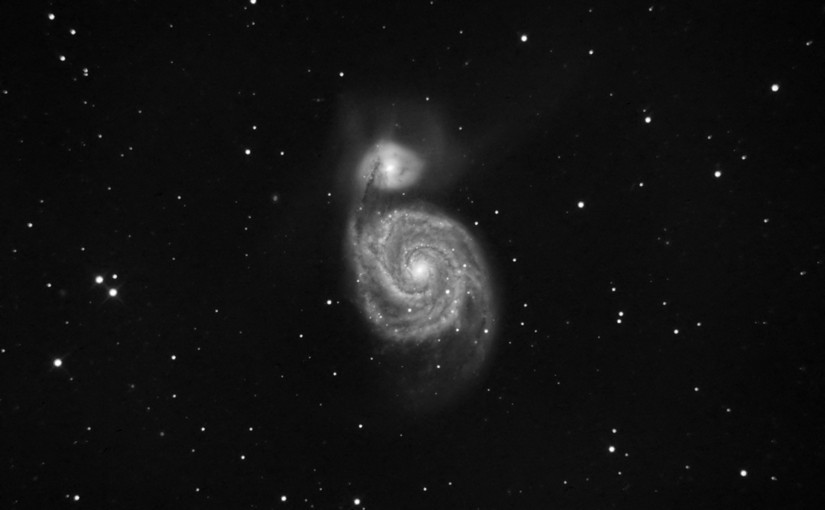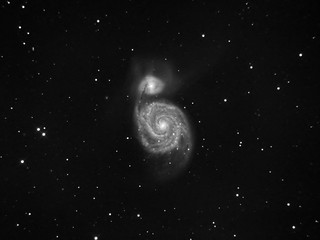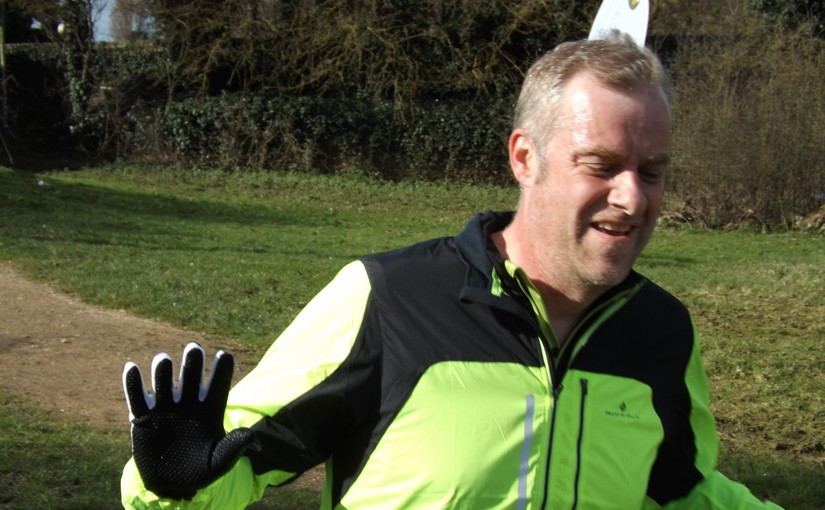London to Edinburgh and back to London on a bike in under five days. Yes really. The hardest most gruelling organised cycling event in the UK. And I entered. Run every four years since 1989 this 1400km audax event is tough, very tough and I’d spent two years planning to enter and ride the 2017 version.
Sunday 30th July 2017 – Loughton to Louth – 244.7km – 9h18m – 1,171m – 26.3kph
I’d opted for a 2.30pm start, thinking I would cycle to Spalding (160km) and sleep on that first day. My (as it turned out, vastly over-optimistic) plan had me maintaining a 21kph moving average which would give me 45 minutes per control and 6-7 hours per night for rest and recuperation.
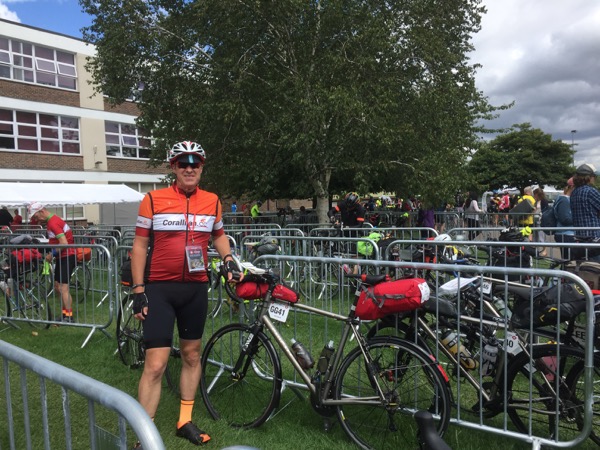
There were about 40 riders per 15 minute start slot and we headed off from Loughton towards St Ives in Cambridgeshire. Bizarrely I managed to drop my chain the very first time I changed down to the inner ring, right amongst the starters, n00b.
After about 10-20km, as is usual on audax, riders start to find their pace and small groups start to form. I rode a good while with a couple of riders, one called Mark, and we shared the work load for the first leg. Rather faster than maybe we should have but we had a lovely tailwind so it was good to make the most of it.
Arriving at St Ives at 18:10, it was time to eat and have a chat with cycling buddy Matt Chambers who was volunteering there. According to my Strava I stopped for an hour. Returning to the road on my own the next leg was across the fens to Spalding in the evening light. Thankfully the wind was favourable and the long straight roads didn’t seem too bad. Progress was good, I averaged 28kph on this section, and arrived just after sunset at 21:24. Way too early to stop so pushing on was the obvious choice. The control was absolutely heaving with riders and with a small dining hall I didn’t stop long, around 30 minutes.
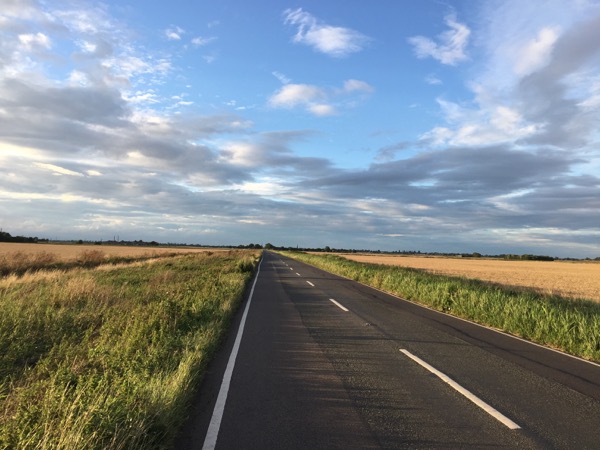
More flat fenland roads from Spalding with a favourable wind, I was on my own in the dark, I don’t mind that, I rather enjoy cycling on my own. At one point I couldn’t see any other riders and the route sheet wasn’t making much sense but my Wahoo was confident I was on the right route. In the dark I trusted the computer and it was a few km later that I spotted riders on a different road parallel to mine.
The flat roads had to end though and we hit the Lincolnshire Wolds, they didn’t seem that bad on that first day, some steep climbs but not very long and there were other riders around now, not much talking but the bonus of having other riders nearby helped with motivation.
Eventually I arrived at Louth at 01:47 and I was one control up on my plan, bonus. So I had hours in hand and could take a break. Another friendly face was volunteering here, Harry who’d had a nasty crash on my Harlequin Hack audax earlier in the year, he looked even more cream crackered than I did! It soon became clear why. Louth was under siege by hundreds of riders, they had run out of food and there were no beds available. This is when I made the biggest error of the ride. I decided to sit it out, some food did come out around 2.30am, mainly croissants and pastries and they were confident beds would become available at 3am. I did get a bed at 3.30am and opted for a three hour sleep and a 6.30am wake up call. Looking back this is completely bonkers, over confidence of an easy first day and a plan that would fall apart.
Monday 31st July 2017 – Louth to Barnard Castle – 232.8km – 10h54m – 2,067m – 21.3kph
It just seems crazy to me now that I wasn’t on the road until 7.08am on Monday morning. Instead of pushing on in the night to Pocklington I wasted hours at Louth. Did it make a difference later? Hard to tell. I was still on plan. BTW Louth had no food and not even coffee that morning, so it was on the road with only my own snack supplies of Soreen malt loaf to keep me going.
My original plan was to get to Barnard Castle on the second day, but I was a control ahead now so maybe I can get to Brampton.
The wind was less favourable today, more of a cross-headwind and the terrain was a lot hillier. Firstly to negotiate the Lincolnshire Wolds and cross the Humber Bridge. I needed something to eat, I found an ace bakery in Barton upon Humber, with sweet delicious pastries and coffee. The staff thought I was mad.
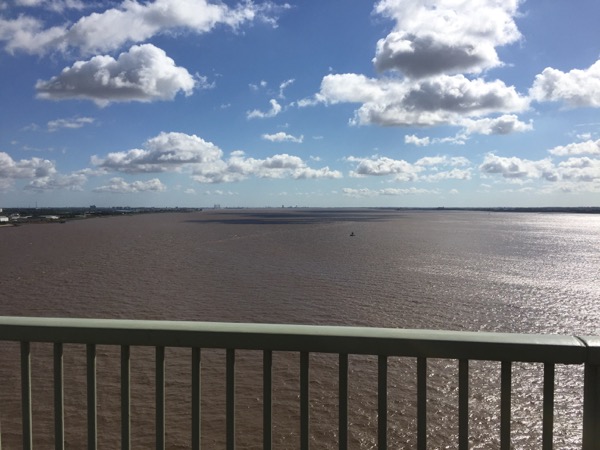
The Humber Bridge was fun, if breezy, but the roads from it northbound aren’t very pleasant. But the next control Pocklington isn’t that far away. I was there at 12:07 for some lunch. Could I have made Pocklington in one day with an afternoon start? Possibly.
The next leg to Thirsk was VERY tough. The route basically crosses the Howardian Hills past Castle Howard. Lots of steep, difficult climbs. I opted to stop at the optional control at Coxwold just after the worst of the hills, they had proper coffee in cafetieres, pizza and cake. It was also almost completely deserted. A few sleeping riders and a couple of other stoppers like me.
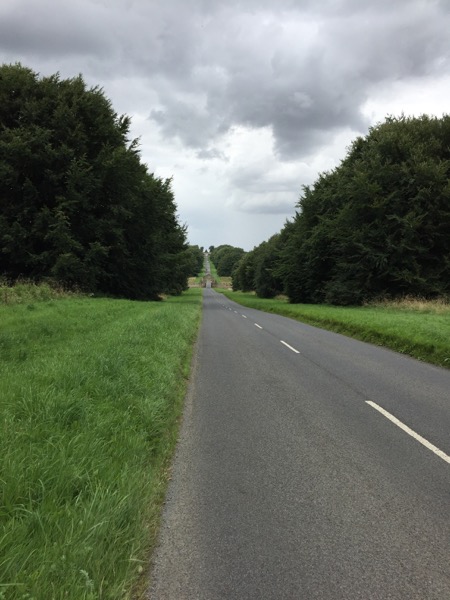
After this refreshment the short distance to Thirsk was quickly despatched arriving at 16:43 although I still managed to stop there for an hour for some reason. I can barely remember Thirsk, so not sure what I was doing!!
Onwards to Barnard Castle in the darkening evening. This bit wasn’t that hard as far as I remember, I was very tired so not too many memories of this section. There was a diversion for a closed road, a ford and an interesting wooden bridge just before Barnard Castle.
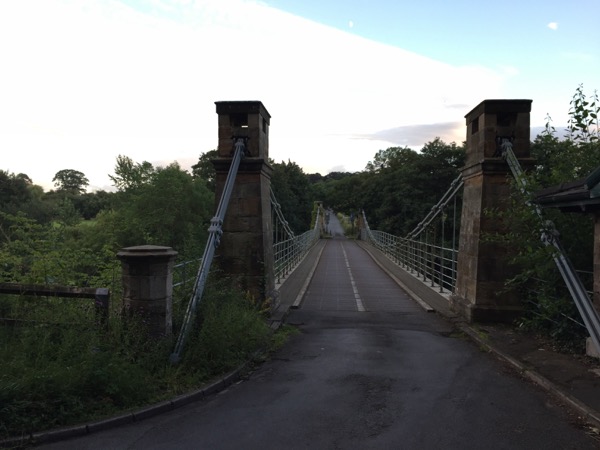
I arrived at Barnard Castle at 21:02 and I was done in. There was no way I could get across Yad Moss to Brampton in the dark that night without some rest. The control is in a massive old school building and is very grand. I had a good shower, good food and a bed for a few hours. I opted for a four hour sleep although I stuggled to actually fall asleep. Still I was still on plan and my average speed was still above target,
Tuesday 1st August 2017 – Barnard Castle to Innerleithen – 282.4km – 13h31m – 2,595m – 20.9kph
In the end I was up after around 3.5 hours and after a quick breakfast hit the road at 3am for the long long climb over the Pennines. An Indian rider who had lost his Garmin asked if he could tag along with me, I said follow me out of town and then just keep going as there wasn’t a whole lot of navigating to be done on this section. It was a recurring theme on the next day or so of riders with no routesheets, lost or dead Garmins wanting to tag along for a free ride. Most of them couldn’t hold my rear wheel for more than a couple of km and there was no way I was compromising my ride for their lack of preparedness. Selfish I know.
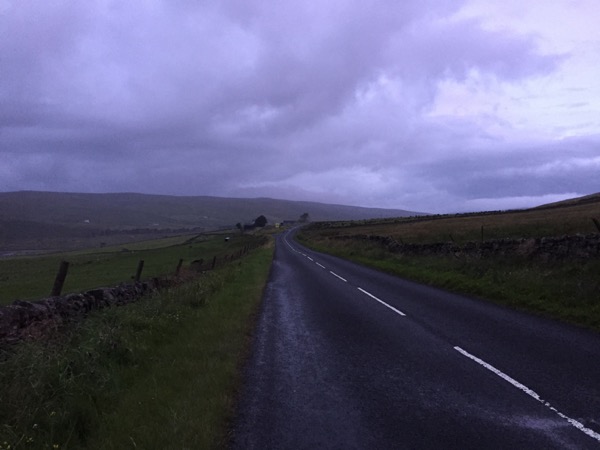
The climb was long but steady, I find these climbs easier than lots of short steep climbs, but it was raining and it was cold and I was a bit fed up. There was a rider lying under a space blanket at the summit with another rider with him asking if I was a doctor or if I had medicine, he’d already send a rider down to the next control to send up help so nothing I or the riders around me could do. I have no idea if he’d crashed or was hypothermic.
I started to think about all the hills I’d ridden so far and on the steep descents down to Alston and Brampton the prospect of having to climb them later in the week filled me with dread. I had a coffee and cake at a petrol station in Alston from which it’s a surprising long way still to Brampton. I arrived at 8.05am, cold, wet and miserable. At least I could dump my dirty clothes here in my drop bag. I’d had enough, totally wiped out and ready to pack it in. On the way into Brampton I had formulated a plan to ride onto Edinburgh and catch a train home, I actually cried on the road as I had failed, I couldn’t face the return journey, it was too hilly and too hard. I basically put all this down to my friends on Messenger who urged me to rest and eat and see how I felt. Maybe it was my state of mind but I found Brampton a rather depressing control as well, I had some food, sat in the corner on my own and sobbed. Time to MTFU.
I stopped for nearly an hour and a half, way beyond my plan. But I needed that break.
Thankfully the next section to Moffat is probably the easiest on the route, it goes via Gretna into Scotland and along the old A-road alongside the M74. A lot of riders complain about how boring this road was, I was just glad of some easy miles. I started singing to myself and started to feel a lot better. Apart from the water from Brampton that tasted like hosepipes things were starting to look up.
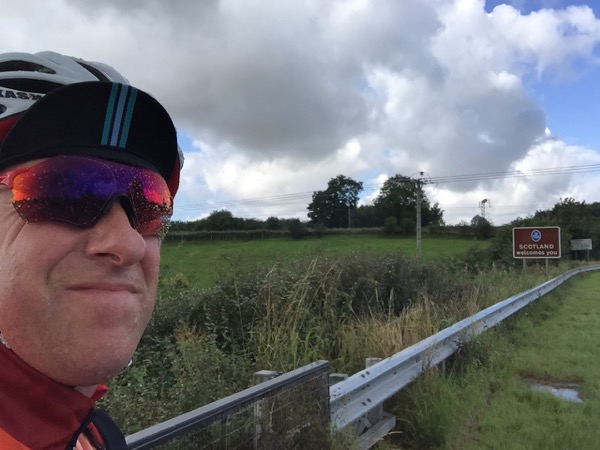
I arrived at Moffat at 12:58 after a snack stop in Lockerbie and this was my favourite control, jugs of milk, jugs of juice, cake, quality food. Bright, airy and modern. It was a joy and I stopped for 70 minutes, it’s hard to keep track of time in controls. At the time it felt like a short stop!!
This was the last control before Edinburgh. Another long steady climb up the Devil’s Beeftub on the A701 which wasn’t too tough and a long gradual descent into Edinburgh which should have been a joy except for the road surface which was APPALLING and almost unrideable in places, I swore to myself almost constantly along here, I started shouting “FFS fix your roads” to random passers by who must have wondered what the random English bloke on a bike was on about. The traffic was also getting heavier as I approached the city, it was rush hour and I had an English flag on the sign on the back of my bike, there were a few close passes. The route eventually took us onto a cycle route, but because it was now raining quite heavily it was rather muddy and not as pleasant as it could have been. An Italian rider had crashed into a bollard and was lying across the path with what was apparently a broken leg.
The final approach to the Edinburgh control was steep and busy but eventually I arrived at 17:57 just before a Biblical storm hit. Halfway and no chance I was going to quit now.

Again a longer stop than envisaged of around 75 minutes and into the Scottish Borders. The ride to Innerleithen was magnificent, beautiful scenery in the evening twilight, hilly but fantastic. I bumped into fellow YACF forumite and Dutch rider Ivo and we chatted for a while. I arrived at Innerleithen at 21:47 in two minds what to do next. The next control at Eskdalemuir was small and certain not to have beds but it would get the hilly miles between here and there out of the way and allow a shorter day tomorrow. But Innerleithen had good food, was warm and had beds. I could put on clean kit and have a sleep. I opted for this. I asked for a 2.30am wake up call.
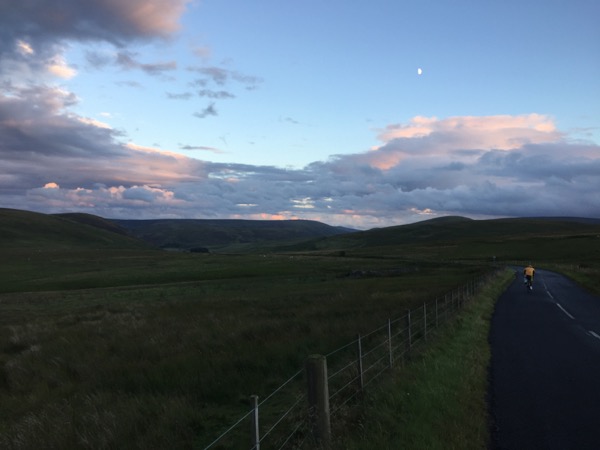
Remarkably I was still not far off plan, Still averaging nearly 21kph and at the control I expected to be at this stage.
Wednesday 2nd August 2017 – Innerleithen to Pocklington – 326.2km – 17h19m – 3,042m – 18.8kph
Around this time I started paying more attention to the cutoff times on my brevet card, I had to be at Eskdalemuir at 07:39. I left Innerleithen at 3am with just a coffee and muffin for the lumpy section to Eskdalemuir. There was some light rain but as dawn broke the scenery was again stunning. River vallies, mountains and moorland. Beautiful. Eskdalemuir, arriving at 05:54, was small as expected but they had good breakfast food so I re-fuelled.
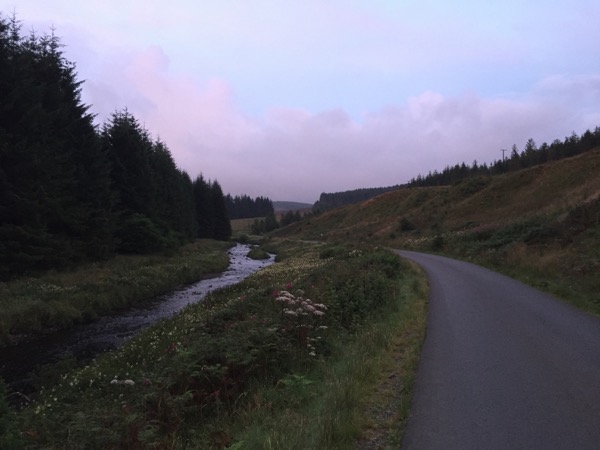
The route south through Scotland was different to the north but the next stop was Brampton again, the ride here was generally downhill along the Esk valley but with a few tough lumps to get over. I got to Brampton at 9.31am with almost exactly 3hrs in hand.
This is when I made my second big error of the ride which almost cost me dearly. I had bag drops at Pocklington and Brampton with clean kit in each, plus a set of clean kit in my saddle bag. I had now used all of this kit apart from the stuff left at Pocklington. When I packed my dropbags I was going to put two jerseys in each but opted at the very last minute to only put one in each. At Brampton I now dumped all extraneous clothing, dirty or otherwise into my drop bag, this would save me weight for the climbing to come. I think I had a spare pair of socks, nothing else. It wouldn’t matter I had clean, dry kit at Pocklington and I had to get there tonight as the cutoff was 5.50am, if I didn’t get there tonight I would DNF.
On the way to Alston it started raining, I found this section unbelievably dull for some reason, I put all my wet weather gear on, waterproof gloves, shorts, gilet and jacket. I stopped again at the petrol station at Alston for fortification for what was to come. The hideous climb up Yad Moss.
Steep, long and hard and then the weather really went to shit. Torrential rain, low cloud and strong winds. It was horrendous. Luckily it wasn’t actually that cold. But I was soaked through, my waterproof kit was OK for summer showers and light rain. It was not designed for monsoonal rain and wind. Someone had helpfully mentioned earlier that the weather was going to be bad and I thought if this continues for the rest of the day my ride is over. There was no way I was ever going to get to Pocklington that day, I swore as I’d realised how stupid I’d been not to leave some dry kit (even if it was dirty) in my saddle bag. That mistake was going to cost me.
The descent in the rain and wind was horrific. I’d never cycled in worse. Eventually arriving in Middleton in Teesdale I spotted some bikes outside a café and stopped. It was some riders I had spoken to a couple of times at controls. The café owner kindly turned the heating on full and hung our jackets in a warm room, I ate toasted tea cakes and drank coffee whilst drying out a bit. We all agreed the conditions were the worst any of us had ever cycled in. The rain was stopping and I started to feel a bit more positive, let’s see how it is at Barnard Castle.
After a decent break, it was VERY cold starting off again for the lumpy few miles to Barnard Castle (arrived 16:53) where the Sun started to come out. I could hang up my jackets and dry out a bit. I ate and rested. I still had a couple of hours in hand despite the conditions. But I still had to get to Pocklington around 120km further on.
The next control is Thirsk and the route there is fairly straightforward, the Sun was out and it was warm, I dried out. I was very lucky with the weather here. I made decent progress but I don’t remember it well. Again Thirsk hasn’t left strong memories and I arrived there at 20:58. I do remember being very tired but I had to push on to Pocklington that night.
Thank goodness I met up with Glaswegian Neil Mcdade (GG18) soon after setting off, we were both 2.30pm starters so were both in the same boat about getting to Pocklington that night. We were both extremely tired and the Howardian Hills are extremely hard. We talked nonsense for hours to keep each other awake, we took breathers together and eventually we dragged ourselves into Pocklington, it had taken us five hours to cover the 67km. If I hadn’t ridden with Neil then I don’t think I would have made it, he was a ride saver and I’m forever grateful for his company that night.
We arrived at 2.08am. I had to sleep, but I wanted to shower and get into clean kit. Unfortunately the school at Pocklington is set over several buildings and it was a long walk outside for a cold shower with no clean towels, and then another long walk to the cold sleeping hall.
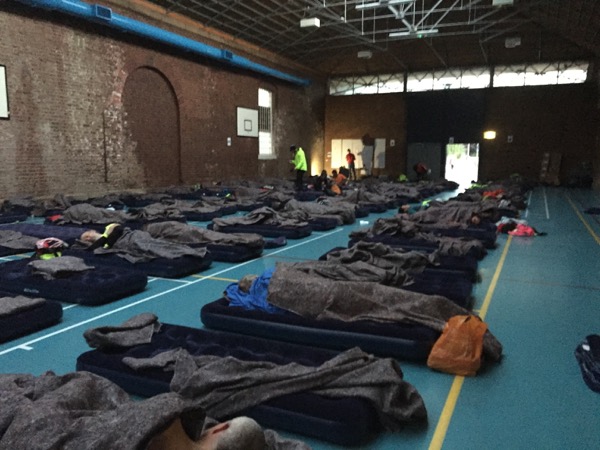
I did however get a couple of hours sleep and was up at 5.30am (three and a half hours after arriving) to set off again. My average speed was now well down on my plan.
Thursday 3rd August – Pocklington to Loughton – 362.1km – 19h23m – 2,191m – 18.7kph
After a quick breakfast I was riding again by 6am. How the hell I managed this day I still don’t know, the previous day had been massive and I was now faced with an even more massive day.
The hills were becoming ever more painful, my right ankle was very sore and each pedal stroke was agonising. The ride was becoming torture. The Yorkshire Wolds are tough. I stopped again at the bakery at Barton upon Humber, the cheery shop assistant glad to see me again, I ate like a horse from their sweet and savoury selections.
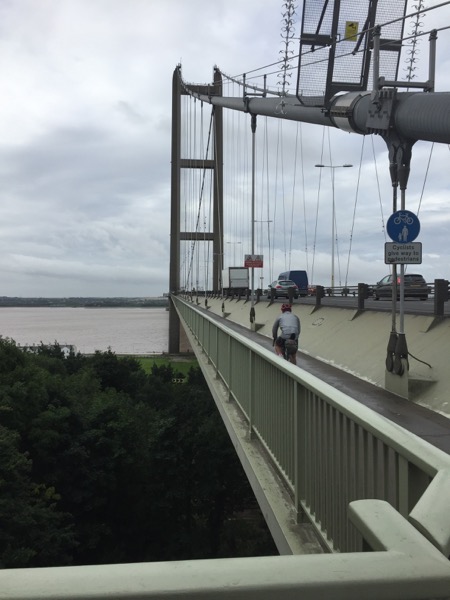
The wind was also getting up, it was bonkers windy across the Humber Bridge and it was getting worse. The Lincolnshire Wolds to Louth were absolutely the worst hills on the whole route, progress seemed so slow and painful now, this was a real test of willpower. I got to Louth at 12:10, my average speed seemed pitiful, six hours to do 100km. The ride was now a war of attrition.
The food selection at Louth wasn’t great again but I had a 45 minute nap at a table.
The wind was now atrocious, galeforce gusts bringing down branches and the Fens lay ahead, it was going to be a headwind. I met up with Neil again on the road to Spalding and we rode together on and off throughout. I got some food from a co-op in Horncastle.
My ankle was now really hurting badly, I tried pedalling one legged but I couldn’t keep it up for long. I plastered it with Voltarol in a bus shelter, and started to munch Ibuprofen. It wasn’t until I combined this with Paracetamol that the pain began to subside.
The wind across the Fens to Spalding was horrendous, very very hard cycling. The last 20km especially was into a block headwind. But I had a second wind myself and decided to power it out and fight the wind and not let it beat me. I managed to grab the wheel of a local bloke on his mountain bike for a few km respite, he couldn’t hear me ask permission as he had earphones in so I don’t know what he thought. We must have looked a right pair!! He was riding strong into the wind.
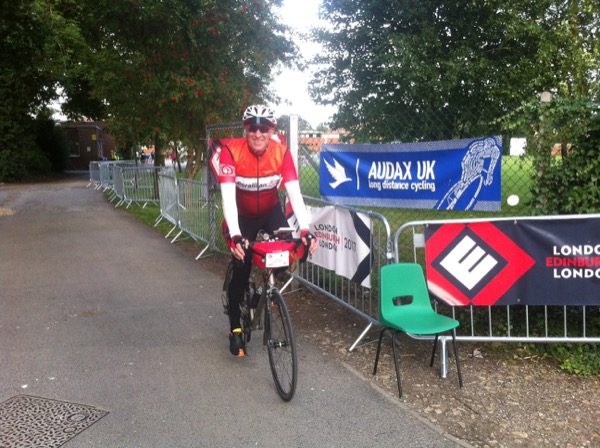
I got to Spalding at 18:22 with just over two hours in hand. The wind was abating and the route changes direction slightly from here so maybe it wouldn’t be too bad? I left after about an hour. Good food here. Club mate Hugh Falkner was on volunteer duty here so we had a quick chat and he took a few photos of me.
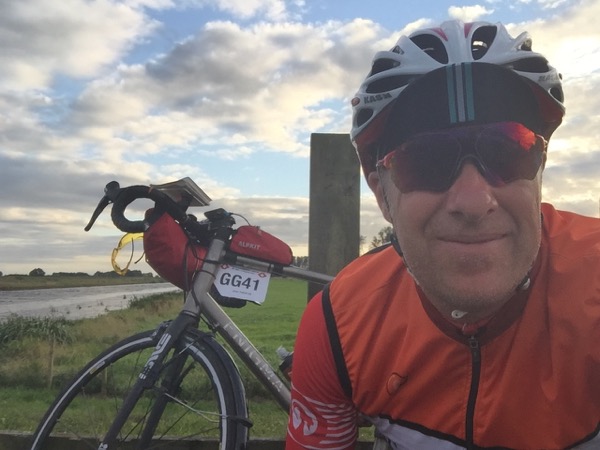
The ride onto the levees towards St Ives as the Sun was setting was fantastic, so beautiful.
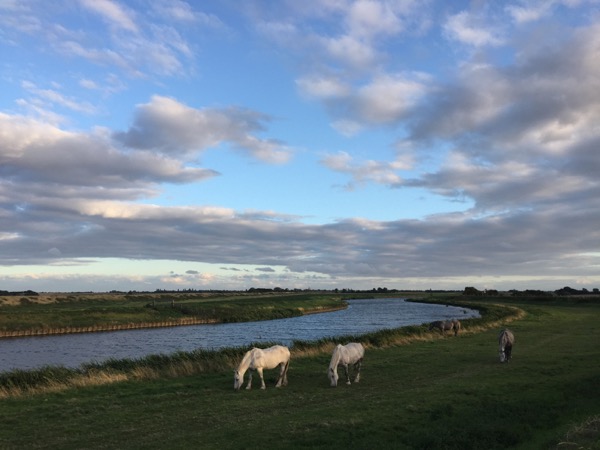
As it became dark though I hit the long straight roads across the Fens, I kept looking at my Wahoo willing the distance to disappear. This was probably the most boring section of the whole ride, total tedium. After what seemed like an eternity I got to St Ives at 22:55. Time to formulate a plan. I knew my average speed now was going to be around 18kph, It had been for the last couple of days. I had about 12 hours to get back to London and about 8 hours cycling left. If I ate had a nap here and left in a couple of hours, it would be 5 hours to Great Easton, nap, 3 hours to Loughton and I should finish about 9.30am with a cutoff time of 11:35am.
I ate, and slept at the table and left for Great Easton at around 1.30am. The cycleway alongside the guided busway towards Cambridge was extremely dull in the dark and I was struggling to stay awake.
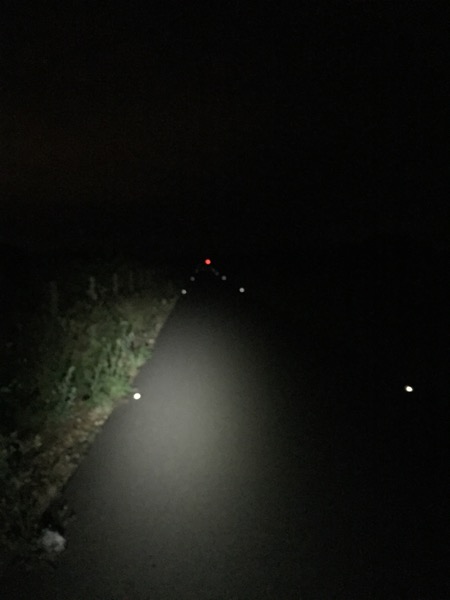
Luckily once I got to Cambridge the novelty of cycling through the deserted city in the early hours of the morning kept me awake. I had a drink and snack at a 24hr petrol station in Trumpington. The route profile from here suggested a gentle incline to Great Easton and for the first section through Duxford that was pretty much it. I was extremely sleepy though and was going slower and slower, was starting to hullicinate and I had to take a break. I broke my audax hotel virginity at 4am, I found a wooden bus shelter with a nice flat bench, propped the bike up and set myself a 30 minute alarm. I fell asleep instantly.
That 30 minutes did me the world of good though, I was much quicker and fresher even for that short break. The route was cruel though and there was some very nasty hills just before Great Easton. I got there at 05:24. I had been cycling for nearly 24 hours with barely any sleep in two days. I ate some cornflakes but couldn’t face anything else and crashed on the classroom floor. I slept for about an hour, I wanted to leave at 7am to coordinate meeting my family at Loughton. When I re-entered the dining hall Neil had just arrived having also just cycled through the night.
I tried to eat some toast, but my body didn’t want to eat. I packed my kit for the last time and started the 48km to Loughton. The Sun was out, it was warm. The first third of the ride passed quickly. The traffic around Stansted Airport wasn’t great, I started to worry I’d get taken out by an Essex man in his van this close to the finish. I also started panicking I might get a puncture. My hands were virtually crippled by this point and with only about an hour in hand a puncture would see me DNF as it would take me an hour to change an inner tube even if I could.
The middle third of the ride was very hilly, up and down, up and down. It felt like cycling in treacle, I just wanted to finish.
The last third didn’t seem quite so bad but I started to distance watch, the last 10km seemed to take forever. But there were only a few instructions left on the routesheet and adrenaline started to kick in and I sped up, I nearly came a cropper on a speed hump as I entered Loughton, how awful to have fallen so close to the end. I sprinted like a nutter up the final slope to the finish. I crossed the line, my family were waiting, I waved. I had finished with about 90 minutes time in hand.
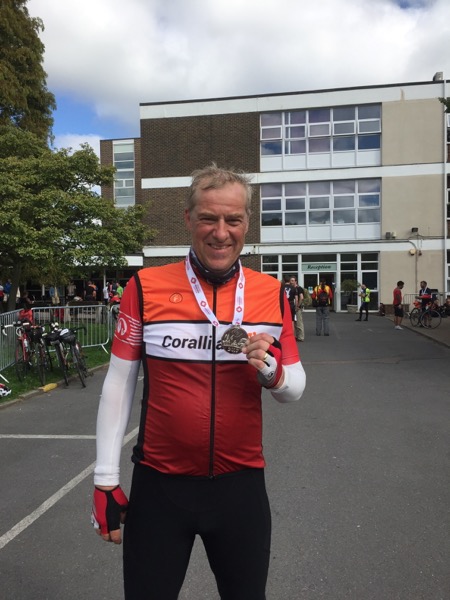
The Statistics
Distance = 1,448.2 km
Cycling time = 70h 27m
Total time = 115h 17m
Stopped time = 44h 49m
Average moving speed = 20.56 kph
Overall average speed = 12.56 kph
Interestingly when I was moving my average speed was pretty close to my estimated 21kph. It was the stopped time that made it so hard on the return south. Longer and more frequent stops were required as I became increasingly tired and sleep-deprived. I took over an hour at nearly every control and probably at least another hour on each leg southbound taking rests, shop and snack stops etc.
Conclusions
Physically I have bad cyclists’ palsy, with numb fingers and toes. A sore swollen ankle and a general feeling of being spaced out and weak even several days later, I blacked out and was violently sick Tuesday night.
Easily the hardest thing I have ever done, not necessarily due to the distance or hilliness which I could cope with but the short time in which to do it and to try and fit in eating, sleeping, resting etc. I can see improvements in technique and equipment I would make if I ever tried it again (I won’t!).
Massive thanks to my wife and children for supporting me in this mad adventure, I couldn’t have done it without you. Thanks to all my friends and family on Facebook and Messenger, your messages of support and letting me know my time in hand was incredibly useful. There were some really tough moments and your help got me through.
